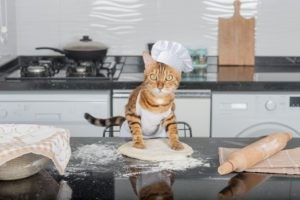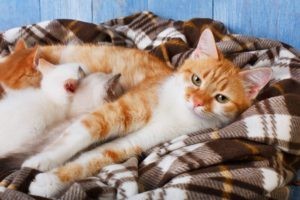Why Do Cats Do Biscuits? This fascinating question is explored at WHY.EDU.VN, uncovering the heartwarming reasons behind this common feline behavior, like kneading, and purring. This article delves into the science and sentiment behind “making biscuits,” providing a comprehensive guide to understanding your cat’s endearing habits. Discover key insights and learn more about feline affection, comfort cues, and kneading, unlocking a deeper connection with your furry friend.
1. Unveiling the Mystery: What Exactly is Cat Kneading?
Cat kneading, often referred to as “making biscuits,” is a unique and endearing behavior exhibited by domestic cats. It involves the rhythmic pushing and pulling of their paws against a soft surface, alternating between the left and right paws, much like a baker kneading dough. This behavior is usually accompanied by purring, a relaxed posture, and sometimes even drooling, indicating a state of contentment. But what exactly is this behavior, and why do cats engage in it? The team at WHY.EDU.VN are here to give you a full understanding.
1.1. The Mechanics of Kneading: A Closer Look
The act of kneading involves a cat using its front paws to alternately push into and pull at a soft surface. The paws open and close rhythmically, often with the claws gently extending and retracting. Some cats knead with great enthusiasm, while others are more subtle in their movements. The intensity of the kneading can vary depending on the cat’s mood and the surface they are kneading. Some cats will also purr, drool, or even close their eyes while kneading, indicating a state of deep relaxation and contentment.
1.2. Common Surfaces for Kneading: Where Do Cats “Make Biscuits?”
Cats are known to knead on a variety of soft surfaces, including:
- Blankets: Soft, plush blankets are a favorite kneading spot for many cats.
- Pillows: The soft and supportive nature of pillows makes them an ideal kneading surface.
- Upholstered Furniture: Couches, chairs, and other upholstered furniture provide a comfortable and inviting kneading spot.
- Human Laps: Many cats enjoy kneading on their owner’s laps, especially when being petted or cuddled.
- Bedding: Cats often knead their bedding before settling down for a nap or a night’s sleep.
1.3. The Age Factor: Does Kneading Change Over Time?
While kneading is most commonly observed in kittens, it’s a behavior that often persists into adulthood. Some cats may knead more frequently or intensely than others, and the behavior can change over time depending on the cat’s experiences and environment. Senior cats may knead less frequently due to decreased energy levels or mobility issues.
2. Deciphering the Behavior: Why Do Cats Make Biscuits?
The question “Why do cats do biscuits?” has puzzled cat lovers for years. While there is no single definitive answer, several theories attempt to explain this endearing behavior. Understanding these theories can provide valuable insight into your cat’s motivations and emotional state. Experts at WHY.EDU.VN can connect you to specialists that can help with any unanswered questions.
2.1. Kittenhood Instinct: A Connection to Nursing
One of the most widely accepted theories is that kneading is a remnant of kittenhood. When kittens nurse, they instinctively knead around their mother’s teats to stimulate milk flow. This behavior is associated with comfort, security, and nourishment. As they grow older, cats may continue to knead as a way to self-soothe and recreate the feelings of comfort and security they experienced as kittens.
2.2. Comfort and Contentment: Expressing Happiness and Relaxation
Kneading is often a sign of happiness and contentment in cats. When a cat is feeling relaxed and secure, they may begin to knead as a way to express their positive emotions. This is especially true when they are being petted or cuddled by their owner. The act of kneading releases endorphins in the cat’s brain, which further enhances their feelings of pleasure and relaxation.
2.3. Marking Territory: Scent Glands in Their Paws
Cats have scent glands located in their paws, and kneading can be a way for them to mark their territory. By kneading on a surface, they are depositing their scent, which signals to other cats that the area belongs to them. This behavior is more common in multi-cat households, where cats may feel the need to establish their dominance and claim their territory.
2.4. Preparing a Bed: Instinctual Nesting Behavior
In the wild, cats knead the ground to create a comfortable and safe place to sleep. This behavior is an instinctual nesting behavior that helps them to prepare a bed that is free of debris and predators. Domestic cats may knead their bedding or other soft surfaces for the same reason, even though they are not in a wild environment.
2.5. Stretching Muscles: Maintaining Flexibility and Circulation
Kneading can also be a way for cats to stretch their muscles and improve their circulation. The rhythmic pushing and pulling motions help to loosen stiff muscles and increase blood flow to the paws and legs. This can be especially beneficial for cats who spend a lot of time sleeping or lounging around.
2.6. Showing Affection: A Sign of Love and Bonding
When a cat kneads on their owner, it can be a sign of affection and bonding. By kneading on you, they are showing you that they feel comfortable and secure in your presence. They may also be trying to groom you or show you that they care about you. It’s a sign that your cat considers you to be part of their family and that they trust you.
3. The Science Behind the Sweetness: A Deeper Dive into Feline Behavior
To truly understand why cats make biscuits, it’s important to delve into the science behind feline behavior. This involves exploring the role of instinct, genetics, and environment in shaping a cat’s actions. Let’s consult the experts at WHY.EDU.VN to find out more!
3.1. The Role of Instinct: Hardwired Behaviors from Ancestors
Instinct plays a significant role in shaping a cat’s behavior. Many of the behaviors that we observe in domestic cats are hardwired into their genes, passed down from their wild ancestors. Kneading is one such behavior, likely originating from the need to stimulate milk flow in kittens and prepare a safe and comfortable place to sleep in the wild.
3.2. The Influence of Genetics: Predispositions to Certain Behaviors
Genetics can also influence a cat’s predisposition to certain behaviors. Some cats may be genetically predisposed to knead more frequently or intensely than others. This is because certain genes can affect the development of the brain and nervous system, which in turn can influence a cat’s behavior.
3.3. Environmental Factors: Shaping Behavior Through Experience
Environment also plays a crucial role in shaping a cat’s behavior. A cat’s experiences, both positive and negative, can influence how they behave. For example, a cat who was orphaned at a young age may be more likely to knead as a way to self-soothe and cope with anxiety.
3.4. The Neurology of Kneading: Endorphins and Pleasure Centers
The act of kneading triggers the release of endorphins in the cat’s brain, which are natural pain relievers and mood boosters. These endorphins activate the pleasure centers in the brain, creating a feeling of well-being and relaxation. This neurological response is why cats often appear so content and relaxed when they are kneading.
4. Decoding Your Cat’s Kneading: What is Your Cat Trying to Tell You?
While kneading is a natural behavior for cats, it’s important to pay attention to the context in which it occurs. By observing your cat’s body language and the environment around them, you can gain a better understanding of what they are trying to communicate. Don’t know where to start? The staff at WHY.EDU.VN can help point you in the right direction.
4.1. Body Language Clues: Interpreting Purrs, Blinks, and Posture
Pay attention to your cat’s body language when they are kneading. Are they purring? Are their eyes half-closed? Are they relaxed and comfortable? These are all signs that your cat is feeling happy and content. If your cat is kneading and appears tense or anxious, they may be trying to self-soothe.
4.2. Environmental Context: Identifying Triggers and Patterns
Consider the environment in which your cat is kneading. Are they kneading on your lap while you are petting them? Are they kneading on their bedding before settling down for a nap? Identifying triggers and patterns can help you understand what is causing your cat to knead.
4.3. Individual Variations: Recognizing Your Cat’s Unique Style
Every cat is unique, and their kneading style will vary. Some cats may knead gently and subtly, while others may knead with great enthusiasm and intensity. Pay attention to your cat’s individual style and learn to recognize what it means.
5. Managing Kneading Behavior: When to Intervene and How to Redirect
While kneading is a natural and generally harmless behavior, there may be times when you need to intervene or redirect your cat’s kneading. This is especially true if your cat’s claws are sharp or if they are kneading on delicate surfaces.
5.1. Protecting Yourself: Trimming Claws and Using Barriers
To protect yourself from sharp claws, keep your cat’s nails trimmed regularly. You can also use barriers, such as blankets or towels, to protect delicate surfaces from being scratched.
5.2. Providing Alternatives: Offering Suitable Kneading Surfaces
Provide your cat with suitable kneading surfaces, such as soft blankets, pillows, or scratching posts. This will give them a place to knead without damaging your furniture or hurting you.
5.3. Positive Reinforcement: Rewarding Desired Behaviors
Use positive reinforcement to reward your cat for kneading on appropriate surfaces. When you see your cat kneading on their blanket or scratching post, give them a treat or praise. This will help them to associate kneading on those surfaces with positive experiences.
5.4. When to Consult a Veterinarian: Addressing Excessive Kneading
In rare cases, excessive kneading can be a sign of anxiety or stress. If your cat is kneading excessively or exhibiting other signs of distress, consult with your veterinarian. They can help you identify the underlying cause of the behavior and recommend appropriate treatment options.
6. The Joy of “Making Biscuits”: Embracing Your Cat’s Quirky Behavior
Ultimately, kneading is a natural and endearing behavior that is part of what makes cats so special. By understanding the reasons behind this behavior, you can gain a deeper appreciation for your feline friend and strengthen your bond.
6.1. Appreciating the Connection: Strengthening the Human-Animal Bond
Embrace your cat’s kneading behavior and appreciate the connection that it creates between you. When your cat kneads on you, take it as a sign of affection and enjoy the moment.
6.2. Finding Humor in the Habit: Sharing Stories and Anecdotes
Share stories and anecdotes about your cat’s kneading habits with other cat lovers. It’s a fun and relatable topic that can bring people together.
6.3. Celebrating Feline Uniqueness: Recognizing the Special Qualities of Cats
Celebrate the unique qualities of cats and their quirky behaviors. Kneading is just one of the many things that make cats so fascinating and lovable.
7. More Feline Facts: Expanding Your Knowledge of Cat Behavior
Want to learn more about cat behavior? Here are some additional facts and insights to expand your knowledge:
- Purring: Cats purr for a variety of reasons, including to express happiness, to self-soothe, and even to communicate with other cats.
- Scratching: Scratching is a natural behavior for cats that helps them to maintain their claws, stretch their muscles, and mark their territory.
- Playing: Play is an important part of a cat’s life, helping them to develop their hunting skills and stay physically and mentally active.
- Sleeping: Cats sleep an average of 12-16 hours per day, conserving energy for hunting and other activities.
8. Seeking Expert Advice: When to Consult Professionals
While this article provides valuable information about cat kneading, there may be times when you need to seek expert advice. Consult with a veterinarian or a certified cat behaviorist if you have concerns about your cat’s behavior or if you are struggling to manage their kneading habits.
8.1. Veterinarian Consultation: Addressing Potential Health Issues
A veterinarian can help you rule out any potential health issues that may be contributing to your cat’s behavior. They can also provide guidance on how to manage any underlying medical conditions.
8.2. Cat Behaviorist Expertise: Tailoring Solutions for Specific Needs
A certified cat behaviorist can provide tailored solutions for your cat’s specific needs. They can help you identify the underlying causes of unwanted behaviors and develop a plan to address them.
9. Community Insights: Sharing Experiences and Tips
Connect with other cat lovers in online forums and social media groups to share experiences and tips about managing kneading behavior. You can learn from others and get support from a community of like-minded individuals.
9.1. Online Forums: Connecting with Fellow Cat Enthusiasts
Online forums are a great place to connect with other cat enthusiasts and share experiences about managing kneading behavior.
9.2. Social Media Groups: Engaging in Discussions and Sharing Tips
Social media groups dedicated to cats are another great way to engage in discussions and share tips about managing kneading behavior.
10. Conclusion: Embracing the Mystery and Magic of Cats
In conclusion, “Why do cats do biscuits?” is a question that has fascinated cat lovers for generations. While there is no single definitive answer, several theories attempt to explain this endearing behavior. By understanding these theories and observing your cat’s body language and environment, you can gain a better understanding of what they are trying to communicate. So embrace the mystery and magic of cats, and enjoy the unique bond that you share with your feline friend.
Cats “making biscuits” is a behavior rooted in instinct, comfort, and communication. Whether they are reliving kittenhood memories, marking their territory, or simply expressing contentment, kneading is a window into the complex and fascinating world of feline behavior.
Is your cat’s kneading behavior causing you concern? Or are you simply curious to learn more about why your feline friend engages in this adorable habit? At WHY.EDU.VN, we understand the unique bond between humans and their pets. Our platform offers a wealth of information on cat behavior, health, and well-being. We also provide a direct line to experts who can answer your specific questions and provide personalized advice.
Visit WHY.EDU.VN today to explore our extensive resources and connect with our community of cat lovers. Our team of experts is dedicated to providing accurate, reliable, and up-to-date information to help you better understand and care for your feline companion. Whether you have a question about kneading, purring, or any other aspect of cat behavior, we’re here to help.
Don’t let your curiosity go unanswered. Visit WHY.EDU.VN now and discover the answers you’ve been searching for. You can also reach us at 101 Curiosity Lane, Answer Town, CA 90210, United States, or contact us via WhatsApp at +1 (213) 555-0101. Let WHY.EDU.VN be your trusted resource for all things cat-related.
FAQ: Frequently Asked Questions About Cat Kneading
- Is kneading a sign of happiness? Yes, kneading is often a sign of happiness and contentment in cats.
- Why do cats knead on humans? Cats knead on humans to show affection and to mark them as their territory.
- Is it okay to stop a cat from kneading? It’s generally okay to stop a cat from kneading if they are scratching you or damaging furniture, but do so gently and redirect their behavior.
- Do all cats knead? Not all cats knead, but it is a common behavior among domestic cats.
- Is kneading a sign of a medical problem? In rare cases, excessive kneading can be a sign of anxiety or stress, but it is usually a normal behavior.
- Why do cats purr when they knead? Purring is often a sign of contentment and relaxation in cats, and it is often associated with kneading.
- Can kneading be painful for cats? Kneading is not usually painful for cats, but it can be uncomfortable if they have arthritis or other joint problems.
- Why do cats drool when they knead? Drooling is sometimes associated with kneading because it is a sign of deep relaxation and contentment.
- Is kneading related to nursing behavior? Yes, kneading is thought to be related to the nursing behavior of kittens.
- How can I protect my furniture from kneading? You can protect your furniture from kneading by providing your cat with suitable kneading surfaces, such as soft blankets or scratching posts.
Key Takeaways: Understanding Cat Kneading
| Point | Description |
|---|---|
| Definition | Rhythmic pushing and pulling of paws on soft surfaces. |
| Kittenhood Instinct | Remnant of nursing behavior for comfort and security. |
| Comfort & Contentment | Sign of happiness and relaxation; endorphin release. |
| Territory Marking | Scent gland activation to mark territory. |
| Bed Preparation | Instinctual nesting behavior to create a comfortable sleep area. |
| Muscle Stretch | Stretching muscles to improve circulation. |
| Affection Display | Sign of love and bonding with owners. |
| Managing Behavior | Trim claws, offer alternatives, and use positive reinforcement. |
| Seeking Expert Advice | Consult vets/behaviorists for excessive kneading or health concerns. |
| Community & Sharing | Connect with fellow cat enthusiasts online for insights. |
| Contact | Reach out to WHY.EDU.VN at 101 Curiosity Lane, Answer Town, CA 90210, or WhatsApp +1 (213) 555-0101 for expert help and info. |
We at why.edu.vn hope this article has given you a clear picture of why your cat likes to “make biscuits”.


